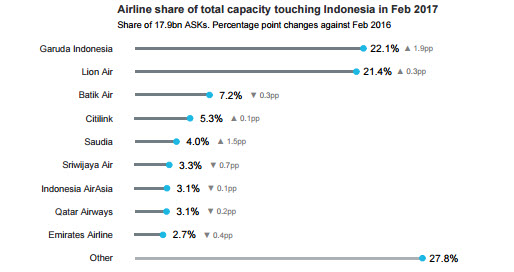Indonesian carriers faced serious yield pressure in 2016 as capacity grew amidst strong competition, and as the country’s economic growth again fell under expectations.
The country’s two largest operators – Lion Group and Garuda Indonesia – made it clear that the past two years have been far from easy, and that their focus is on keeping costs low to offset any revenue decline. The depreciation of the rupiah against the dollar has not helped either.
Garuda has yet to release its 2016 financials, while privately-owned Lion Group keeps its financials private. Lion Group founder Rusdi Kirana however told FlightGlobal earlier this year that Indonesian units Lion Air, Batik Air and Wings Air merely broke even in 2016. This is in contrast to 2014, when Kirana said that the carrier is solidly profitable and making “10, 20 times more than Garuda”.
Indonesian carriers take stock as competition intensifies Garuda chief executive Arif Wibowo on his part said that 2016 has been a struggle for both the group’s mainline carrier as well as low-cost unit Citilink. He is however still targeting profitability for both airlines.
Indonesia’s domestic capacity, in terms of ASKs, jumped 13.7% to 104.3 billion in 2016, higher than the 9.4% growth in the previous year. This is largely attributed to capacity growth at Citilink, Batik Air and Sriwijaya Air with new aircraft deliveries.
This year, Lion is targeting to increase capacity by 30% - simply by raising aircraft utilisation from eight to 10 hours. Kirana concedes that there is an oversupply of capacity in the market, and says he expects further consolidation in the market, where only the fittest will survive.
The group has a further 435 aircraft on order, but the majority of the aircraft it will be taking this year will go to Malaysian unit Malindo Air.
“My strategy is to keep costs as low as I can,” says Kirana. “Some things such as the economy are beyond my control – but what I am skillful at is to make the airline the strongest in terms of costs, reliability and safety. If we can do that, even though the economy is not as good as we had expected, we can still survive,” he says.
Similarly Garuda has been working to reduce its fleet and overhead costs. These involve restructuring the organisation and routes to ensure optimum efficiency. It also wants to increase its cargo revenue. “I need to make sure that even though the yields are down, we can cover [the shortfall] with other things,” says Wibowo.
The country’s third largest operator, Sriwijaya, meanwhile has flown quietly under the radar. The privately owned carrier does not make public its financials, but says that 2016 was its best year ever – in terms of profitability - and has even set a target to be the most profitable player in Indonesia.
The carrier said it did well in 2016 because of a boost in charter operations – it carried about 50% of all Chinese tourists into Indonesia – and also operates profitable charters for mining companies. The group’s strategy differs from the big boys – it operates mostly older and cheaper Boeing 737s, taking them from lessors and having the flexibility to grow its fleet according to market demand.
Sriwijaya believes there remains plenty of domestic opportunities, considering Indonesia’s 250 million population and still-strong annual economic growth of 5%. Besides the mainline carrier, it also has a three-year-old subsidiary Nam Air.
This year Sriwijaya will aggressively induct 15 737s, while Nam takes 12 ATR 72-600s – its first turboprops. Its focus will still be on flying domestically, with its only international route being Medan-Penang. It also working to list on the Indonesian Stock Exchange by May.
“This is to make the company even stronger, to raise money so that we can take more aircraft. After the IPO we will be able to double our fleet within three years,” says Jefferson Jauwena, Sriwijaya’s director of corporate planning and business development. “The aim is for the company to be the most profitable airline in Indonesia. It’s really not about how big the company is, but rather how healthy it is.”
This is an extract from Flight Dashboard's Indonesia country report, featuring a breakdown of capacity, fleet and news analysis, which can be downloaded from the Reports section here. To find out more about Flight Dashboard, click here.

Source: Cirium Dashboard


























